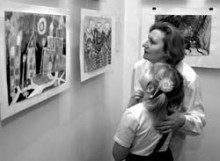On the eve of St. Nicholas, the galleries located on Kyiv’s Kostiolna Street (Griffin, Watercolor, Family Home, Kolta-A, Nile, and the Art Center on Kostiolna) hosted the “Children to Children” art project. More than 200 pupils, aged three to fifteen, from Kyiv’s art schools as well as children undergoing an art therapy course at the Pediatric Department of the Ukrainian Institute of Oncology took part in this exhibition/competition of children’s art works. By far the most interesting highlight of the show was a charity auction to which the little artists submitted 104 works, such as drawings with a childlike vision of the world and clay whistles, horses, and angels. One hundred and four lots and a large picture executed by 12 pupils of Kyiv’s Children’s Art School No. 2 were valued at between 50 to 250 hryvnias. During the auction the adult visitors frequently commented that there is nothing more touching and righteous than when one child helps another. All the proceeds of this auction will go to a noble cause — funding the art therapy course at the Pediatric Department of the Ukrainian Institute of Oncology.
The works of the children who attend art schools and those who live in the pediatric ward convey the same message: life, the sun, brilliant colors, nature, and love. According to Hryhoriy Klymniuk, chief of the Pediatric Oncology Department at the Institute of Oncology, this is a very important project. This is the first exhibit by the patients of the institute’s Pediatric Department. “Until now, our children’s works would be taken by sponsors, mostly from Germany, who would display them in their country and hold auctions,” Klymniuk says. The department has never had such excellent art therapists before, who are teaching the children to make beautiful works of art in a short period of time. Foreign researchers claim that art therapy sessions greatly improve not only a child’s general condition but also the results of blood and urine tests. This is also the first time that a charitable auction was held in Ukraine to benefit children who are receiving treatment at the institute. “Because of chronic underfunding, it is very important to be able to attract funds from patrons, philanthropists, and charities for effective treatment for our children,” Klymniuk explains. “This enables us to procure medicines and equipment as well as to give an impetus to the development of children’s art therapy and psychotherapy. Children who have to stay in hospital for a long time and are thus deprived of their customary surroundings badly need psychological support.”
In the opinion of Olha Kovalenko, member of the Ukraine- 3000 international charitable foundation, there will be more auctions like this in the future. “For if other individuals and organizations pick up on this initiative, this will benefit sick children, children who create, children who help, and the adults who witness this,” she said. Her foundation immediately bought a picture called “At the Seashore” by nine-year-old Hanna Tereshchenko. Asked by The Day’s correspondent why she bought this picture, Kovalenko said, “Because it radiates what we call happiness. It shows everything at once: a boy and a girl, the earth and the sky, and the harmony of all colors. This is the view of a person who can see the bright side of life.” The exhibits in the Kostiolna St. galleries closed on Dec. 25, but donations can be made any time.
COMMENTARIES
Oleksiy DOLIA, ethnographer, Museum of Folk Architecture and Folkways of Ukraine:
“It is an old tradition to celebrate Dec. 19 in Ukraine. St. Nicholas the Miracle-Worker is one of Ukraine’s favorite saints. He is the patron saint of those who travel by water. This was never taken literally because every person saw himself as a traveler on the sea of life and prayed to God for grace. This day was celebrated differently in different regions. For example, the residents of Halychyna used to bake ‘St. Nicholas cakes.’ In the Poltava and northern Ukrainian regions these cakes, called ‘panianky’, were baked for Christmas Day in the shape of birds and animals, including horses and riders. On Christmas Eve, when children would carry supper to their godparents, they were given such cakes. It is no accident that the following song was composed:
On a quiet winter night
We will ride to the Sich,
And the kish otaman will give a Christmas ginger bread.
“Unfortunately, this custom, like many other folk rites, has been almost lost in central and eastern Ukraine. Only a few old people can remember and describe it. In the Soviet era St. Nicholas was replaced by Grandfather Frost. So we can say that today, by force of historical circumstances, this tradition is usually observed in Halychyna, Bukovyna, and Transcarpathia, where it was better preserved. Now that Ukraine is independent and the Ukrainian Autocephalous Orthodox Church and the Ukrainian Greek Catholic Church have been revived, this feast is making a comeback. I think that in due time, not in one or two years from now, of course, Dec. 19 will be marked everywhere. These traditions have very good prospects because they reflect the Ukrainian outlook and mentality. I am sure that Halloween will never take root here, for it is an alien and artificial feast brought in by a foreign mass culture.”







